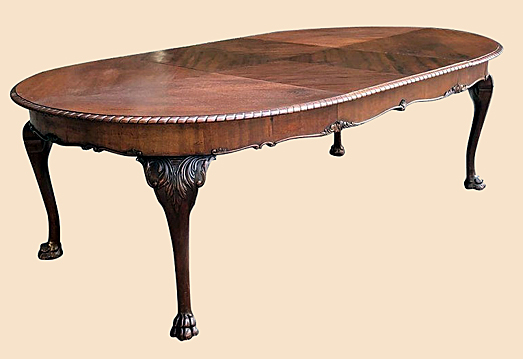 |
| Chippendale style dining table and chairs 1930s |
QUESTION: I’ve been looking for a new dining table and chairs. But the new ones I’ve seen don’t look very well made for their high cost. A friend suggested I look at buying an antique set. I found a beautiful Chippendale set in a local antique shop. It’s a beautiful set, but how can I be sure it’s the real thing? The shop is reputable so I don’t have any reason to suspect the sets authenticity. How can I be sure it’s authentic?
ANSWER: You have every right to be suspicious. Even reputable dealers have been fooled by copies of 18th-century pieces coming out of Indonesia. The makers of these pieces do such an excellent job of copying every detail that it’s often hard for some dealers to be sure.
The Indonesian copies are only the latest in a long line of reproductions. Most people think that because a piece of furniture of a particular older style that it must be a antique. People fail to realize that certain popular styles of furniture have been reproduced over and over throughout the last several centuries.
 |
| Indonesian Chippendale dining table replica |
 |
| Chippendale style dining table with two leaves 1900 |
 |
| Small Chippendale dining table late 18th century |
At the time Chippendale furniture was popular in the mid 18th century, dining tables like this one with added leaves didn't exist. Dining tables with separate leaves didn’t come into use until the 19th century. During the 1750s, "joyners"—the person’s who made furniture—made dining tables as drop-leaf tables with large leaves or wings that could be folded down and stood against a wall until ready for use. In many cases, the owners stood them in their front hallways to allow for more space.
A wealthy 18th-century family would have only used a larger table like this when dining with guests. They often ate at a smaller table by the fire, especially in winter, or had “tea”–what we call supper–in their bedrooms by the fire. When not in use as a dining table, they may have used it for other things and stood the chairs against the wall around the room. In fact, cabinetmakers sold the tables and chairs separately, not in sets.
 |
| Georgian Chippendale dining table made from three solid mahogany boards |
At the end of the 19th century, a style called Colonial Revival came into popularity because of the colonial exhibits at the Philadelphia Centennial Exposition in 1876. Furniture makers began to make what they thought looked like colonial furniture although it was often stylized and lacked the fine details of the original.
Also, cabinetmakers in the 18th century used pegs to join furniture, thus the name "joyners." After the start of the Industrial Revolution in 1830, screws came into common for joining parts of furniture. Early cabinetmakers also carved their names or initials on their pieces. By the second half of the 19th century, furniture makers began to affix labels on their products.
 |
| Queen Anne side chair of Bermuda cedar |
And even antique experts can be wrong. A dealer rejected an 18th-century Chippendale drop-leaf dining table and one chair as not being authentic because the wood wasn’t mahogany, the traditional wood used on such pieces. It turned out that the table and chair were authentic after all. It seems they were made of Bermuda cedar, now long extinct. This wood is more orange in color than mahogany. Although this dealer was the expert on 18th-century furniture in the area, the owner took the table and chair to other dealers who all agreed with him. It was only after a friend saw an identical table in an historic house while on a trip to Bermuda that the owner was able to determine the true age of his table and chair.
That said, this table and chairs seems to be well constructed of solid mahogany and, therefore might sell for somewhere between $1,500 and $3,000. But don’t mistake the identity of this dining set for the real thing which might sell for upwards of $5,000. It isn’t.
To read more articles on antiques, please visit the Antiques Articles section of my Web site. And to stay up to the minute on antiques and collectibles, please join the over 30,000 readers by following my free online magazine, #TheAntiquesAlmanac. Learn more about "Celebrating an Olde Fashioned Holiday" in the 2020 Holiday Edition, online now. And to read daily posts about unique objects from the past and their histories, like the #Antiques and More Collection on Facebook.





